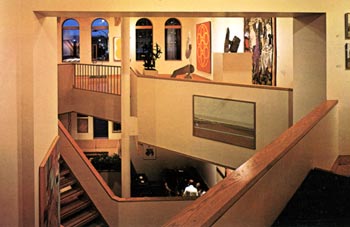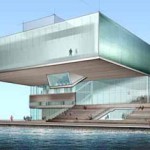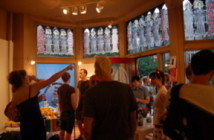Founded in 1936, the Institute of Contemporary Art is one of the oldest non-collecting contemporary arts institutions in the United States. We strive to share the pleasures of reflection, inspiration, provocation, and imagination that contemporary art offers through public access to art, artists, and the creative process.- Mission Statement of The Institute of Contemporary Art, Boston MA.
The Institute of Contemporary Art opened in 1936 as the Boston Institute of Modern Art - a sister institution of the Museum of Modern Art in New York, under the direction of James Sachs Plaut who "envisioned this new institution as, ‘an experimental laboratory in which we would present a platform for things that were happening on the contemporary art scene.'"[1] This vision has been fulfilled by various means over the seventy-year history of The Institute. More recently, under the direction of Jill Medvedow, the ICA has taken an opportunity to push this goal to a greater extent. With the announcement in 2000 that The Institute would be relocating to a state of the art building in the Fan Pier development on the South Shore of Boston and that it would begin to collect works that are not only contemporary but reflect the exhibition history of The Institute, Ms. Medvedow has radically increased the scope of influence the ICA will have on the art world and the city of Boston. According to the director, "The design of the ICA embraces and bridges dual objectives -- the museum's mission to become both a dynamic space for public activity and a contemplative space for experiencing the art of our time.'" [2]
Some other cultural institutions in Boston feel that awarding the Fan Pier space to the ICA was unfair (The Boston Ballet, and the Wang Center* were also in competition for the location.) Medvedow counters the criticism of those institutions who were not lucky enough to win with cool confidence, referring to the necessity of Contemporary Art to the community: "We had the best project and plan for the site. There is nothing more glorious than seeing an underdog win. We were able to show the success of contemporary art museums around the world at instilling civic pride and coalescing local communities. We had done our homework about why art matters."[3] And certainly the ICA has and does play an important role not just in the art world, but also in the city of Boston as a whole. It has on numerous occasions been the first institution to exhibit works by artists who are now icons in the canon of 20th and 21st century art- Andy Warhol, Robert Rauschenberg, and Cindy Sherman to name a few. In addition, its Vita Brevis program brings art into the public spaces of the city. In this new home, the ICA will be able to acquire and exhibit a collection of works by these artists and others that reflects the history of the institute and provides a context for the cutting edge temporary exhibits of Contemporary work that the ICA is known for.
Since its inception, the Institute has been housed in several recycled buildings around the city of Boston. It's most permanent, the location at 955 Boylston street, where the institute moved in 1975*. Scheduled to open in 2006, the new ICA will be three times the size of the current refurbished police headquarters on Boylston Street and will house the Institute's new permanent collection. The ICA, one of the country's oldest contemporary art institutions has never been able to amass a permanent collection, reputedly, for lack of space.[4]In its seventy year history the ICA has been a show house for seminal exhibits of contemporary art, as well as an underdog of the Boston museum scene. Boston is a city that favors the traditional. The Massachusetts Museum of Contemporary Art is, strangely 153 miles outside of the city, only 54 miles closer than the Museum of Modern Art in Manhattan.[5] The ICA, the Contemporary Art museum in the city proper has not previously been able to develop the impetus or funding to move into a larger, more traditional space.
The placement of a large museum on the Fan Pier development is not unexpected, they had planned from the beginning to offer space to a cultural institution, it is the nature of the institution taking the space that is surprising. It reflects perhaps a transformation in the mindset of the city, and particularly those citizens that fund museums. Only $130,000 of the $60 million needed to complete the new building is being provided by the state, the rest of the money is coming from corporate and individual donors interested specifically in contemporary art and it's position in the community. In a place where both of the well known art institutions focus their collections around works that are part of the traditional art historical canon, or at least related to it, the ICA has been something of a white elephant. But, it provides an interesting foil for both the Isabella Stuart Gardner Museum and the Museum of Fine Arts, Vin Cipolla, chairman of the board of directors at the ICA describes it in this way, "In Boston we are blessed with very important institutions that look at art history, that look at things from the perspective of where we have been rather than where we are going. The role of the ICA in this city is about the future…the prominence of the site suggests this is a city about receiving these contemporary ideas."[6]
The ICA's current home is not necessarily the tight space restraining The Institution from expanding that it has been described as by the Director and curators. The current space provides very intimate encounters with the works of art that are installed there; it allows the visitor to become immersed in and in some ways, a living part of the exhibit. There is nothing sterile, or Institutional, about a visit to the current ICA. The encounters that this space provides are incomparable to that of the typical museum, whether it has a collection of Modern Art or not. Consider the differences- One approaches the ICA off a busy urban street, there is no surrounding green space, no majestic architecture, no feeling that you are entering the sanctified home of ART. Though, the entrance to the building is framed with a barrel vaulted arch, it does not impart the same message as an imposing neo-classical façade or a glimmering post-modern architectural sculpture with all of its glass and glittering metal. Once inside, the space is small, inviting. Even when the exhibit is a hang of pictures and objects in a manner similar to that seen at most major museums, and not an installation that fundamentally changes the shape of the interior, there is no sense of having entered a museum. It is more comfortable, less imposing, and in many ways less overwhelming than the Museum of Fine Arts, or MoMA- there are never more than one or two exhibitions occurring simultaneously. The experience is manageable and allows the visitor to become imbued with the mood and message of the show. The path through the exhibit is always clear, there is really only one way to move through the space, and there is no pressure to get on to the next seminal piece or the next chapter of the collection- there is only the exhibit at hand. In the new space, this intimate character will be lost.
The new ICA will be a glorious exercise in modern design. It will celebrate the surrounding environment of the harbor, the collection and exhibitions within. The building is directly on the water. It appears, in digital models, to float over the harbor almost unsupported. A metal and glass structure with a large cantilevered exhibition hall, a three hundred-seat theater, a digital media center, an education center, café and bookstore, it will be everything the current ICA is not. Instead of being lit entirely incandescently, the new building relies on natural light filtered in through the ceiling and walls to light the exhibition space and the theater. The skylights are adjustable, and appear from aerial views almost like solar panels. This method of lighting speaks to the goal of the architects to, "Build the Collective public building from the ground up and the individual contemplative building from the sky down."[7] The building blurs the boundaries between outside and inside in an innovative manner, the entire wall of the upper level gallery is lenticular glass that permits vision out when viewed from a perpendicular angle, but prevents vision from other directions.[8] This display of virtuosity has many merits, but it seems likely that it will detract from the experience the visitor has with the art, placing more emphasis on the experience with the space. The ultimate goal is obviously to provide a new kind of experience- the experience of attending a museum, rather than a small gallery.
There are important differences between the word Museum and the word Institute. The Oxford Desk Dictionary and Thesaurus Defines these words as such:
Institute: N. A society or organization founded especially for a particular purpose. Synonyms: Initiate, create, and install.
Museum: N. Building used for storing and exhibiting objects of historical, scientific, or cultural interest.
Implicit in the word museum is the idea that the institution that chooses to call itself a museum acts as a receptacle for objects, even when they are on display. The word institute is much more dynamic and is inclusive of the word and idea of the museum. Perhaps the naming the ICA, the Institute of Contemporary Art was related to the fact that it would not be able to amass a permanent collection within the confines of it's own building. But, now that the ICA is moving into it's new home it will be able to both store and exhibit works, not just display them, and then send them along. This transition marks a fundamental change in the Institution; the Institute will now be a Museum.
Instead of hosting one or two small exhibits at one time, the new space will allow the curators to install up to four or five exhibitions simultaneously. While this is certainly an impressive transition, it seems that in the excitement to blossom into a full-fledged museum, the ICA has decided to eschew many of the positive elements of it's former constraints in favor of creating a more impressive statement. To quote Assistant Curator Emily Moore:
Certainly, our unique space on Boylston may lend itself to funky site-specific works, like the current Hirschhorn exhibition, more than the traditionally laid-out spaces of the new building. I think the new space will allow us to do the kinds of things we've done before -- groundbreaking exhibitions of emerging artists -- as well as things we CAN'T do in our current space because it is too space [focused]. Namely, mounting large-scale exhibitions of artists with even more name recognition.
Certainly this will be a new experience for those who have visited the ICA regularly in the past when name recognition hasn't necessarily been an issue of concern when mounting exhibitions. In fact, one of the things that sets the ICA apart is that frequently only those "in the know" will recognize the names of artists exhibited there. The exhibitions at the ICA have formerly served to introduce lesser-known artists to the wider public, now it seems there will be more emphasis on shows that could be considered blockbusters, or at least, crowd pleasers. This is a Janus faced situation- on the one hand, exhibitions of well-known artists draw large crowds and diverse audiences. On the other hand, they may repel, or at least create a feeling of distaste, in those who have been particularly enthralled by the experience of having close encounters with the work of artists who are not widely known -- this audience, "mostly young, "hip," educated white kids in their twenties," in the terms of many of the people who work at the entrance to the ICA, may be less likely to make the trip to the new ICA on a regular basis. But, the people who don't come now may be more likely to--They will know the names of the artists exhibited there, they will be able to "make a day of it," have lunch, go shopping. Now, a visit to the ICA can be accomplished thoroughly in about an hour. This new customer draw will be beneficial for the ICA on a financial level, but at the same time, it may have to find a different, loyal, base of visitors than it currently entertains.
In addition to the new location and vastly increased capacity for temporary exhibitions, the ICA had begun to acquire works for its permanent collection. Assistant curator, Emily Moore expresses a positive view of the possibilities available to the country's oldest non-collecting contemporary art institution developing a permanent collection:
The ICA has decided to begin acquiring art in order to provide visitors to the new building with broader and more lasting experiences. By establishing a permanent collection, the ICA can install long-term exhibits of contemporary art that enhance and complement the ICA's primary area of focus: temporary exhibition programming. The board's Collection Policy Committee identified several specific objectives for establishing a collection policy: to provide a context for traveling exhibitions; to familiarize the visitor with recent developments in contemporary art on an ongoing basis, bringing continuity to what has been until now a sequential series of experiences; to selectively document the ICA's exhibition through acquisitions from exhibitions the Institute has presented; to provide New England's contemporary art collectors with an appropriate institution to house selected gifts from their holdings; and to allow for cost-effective long-term education programming that is prohibitively expensive.
By establishing a Collections Policy, the ICA would be the only public institution in Boston devoted to exhibiting and collecting contemporary art, and become a major resource for promoting and circulating contemporary art throughout New England and beyond."[9]
This collections policy is in agreement with the desires of the original director, James Sachs Plaut's wish that the ICA display Contemporary Art in a way that specifically interprets it in a "conscientious and forthright" manner, bridging the ideological gaps between the artist and the public, who is not necessarily versed in the language of modern art.[10] By using the permanent collection to establish a context and sense of continuity between the more recognizable work of those Modern and Contemporary artists who have become inextricable from the idea of Modern/ Contemporary Art itself and those new artists whose work the ICA delights in showing, The Institute will hopefully be able to create an environment in which the visitor can draw his own connections and interpretations between the traditions of the avant-garde and the new work he is imbued with by the temporary exhibits. This encouragement of knowledge and personal involvement is also present in the spaces of the new building that are not primarily set aside for the display of art. Specifically, the Bank of America Art Lab, which we will be a teaching space that provides, "…places to get dirty and make art…"[11] an interactive space for the public to engage not only with the visual experience but also the more tangible, personal, creative experience. The kinds of connections that will be made in spaces like the Art Lab will hopefully make contemporary and modern art a more accessible experience for more people. In other words, the ICA will have created an environment, which if used to its greatest possibility will provide numerous contexts and interpretations of Contemporary Art.
The desire to embrace the art of its time and urge others to a similiarly passionate involvement has always been a cornerstone of the ICA. The belief that an intimate relationship with contemporary art provides people with an important way of better understanding their own times has inspired the generations of professionals and volunteers who have kept the ICA vital and adventurous.[12]
This statement, from the foreword of the 1986 Dissent: The issue of Modern Art in Boston, Catalogue underscores the past of the ICA and predicts what its efforts will be in the future. If this intimate character is truly a defining element of the institution than it may be expected that despite the more traditional spaces afforded by the new museum building, the ICA will try to organize its exhibits in such a manner that encourages the kind of intimate encounters made possible by the old gallery. The exhibition space, on the top floor of the new building, is column free, with moveable walls. This flexibility should allow the staff to install temporary exhibits that mimic the character of exhibits like the current Hirschhorn installation or the Kai Altoff exhibition of 2004, both of which allowed the visitor a heightened experience with the work of a single artist. This kind of flexible space is not new, Le Centre Georges Pompidou in Paris makes use of similar methods to manipulate the space of their galleries. Both buildings, the Richard Rogers and Renzo Piano Pompidou center and the Diller Scofidio+ Renfro-designed ICA, use flexible walls and high-modern glass and metal designs focused on the display of modern building technology as the most condusive context for housing modern art. Though, the design of the new ICA is much more sleek than that of the Pompidou center, both were designed and realized with very similar goals in mind. When Georges Pompidou decided to designate the area where the museum is today as a museum space he made a statement very similar to those made by Jill Medvedow in relationship to the decision to build the new ICA: " I wish passionately that Paris could have a cultural center that would be both a museum and a center of creativity -- a place where the plastic arts, music, cinema, literature, audio-visual works, etc. would find a common ground."[13] Despite the similarities between the two institutions, the Centre Georges Pompidou was built in the 1970's, and despite all the promise and interest of its architechture, it is not necessarily a successful space for viewing art. In a 1977 review of the building in Art Journal the experience of the Pompidou Center is described as such," One feels as if the paintings and sculptures blend with their fluid surroundings -- losing much of their individuality."[14] Hopefully, the curators at the ICA in Boston will take the experiences they have had working in the confined space of the Boylston street police station and create exhibits within the new space that have the same cohesion and intimate character, allow for the same dialogue between the visitor and the work of art. It would have been wise for the ICA to keep the Boylston Street location as a small satellite of the larger museum where they could install exhibits one at a time to insure the ability to present this kind of intense, choreographed experience while simultaneously exploring the new freedoms allowed in their new museum.
----
[1] http://www.icaboston.org/home/information November, 17 2005
[2]Kuronen, Melissa. Press Release dated November 17, 2005. The Institute of Contemporary Art, Boston To Open New Diller Scofidio +Renfro-Designed Museum In September 2006: New Waterfront Museum to House Expanded Multi-Disciplinary Arts Programming.
[3] http://www.artnet.com/Magazine/features/miller/miller12-5-00.asp November 17, 2005
[4] http://edition.cnn.com/2003/TRAVEL/DESTINATIONS/12/04/contemporary.museum.ap/ November 17, 2005
[5] Mileage calculated using Yahoo Maps.
[6]http://edition.cnn.com/2003/TRAVEL/DESTINATIONS/12/04/contemporary.museum.ap/
[7] Wall text From Building A Vision: Diller and Scofidio in Boston Exhibit at the ICA, Boston 22 January- 27 April 2003.
[8] http://www.icaboston.org/information/thenewica/design.cfm March 22, 2003 3:53pm
[9] From an interview with Emily Moore, November 18, 2005.
[10] From Modern Art and the American Public: A Statement by the Institute of Contemporary Art, formerly the Institute of Modern Art. February 17, 1948.
[11] Costello, Rebecca. Article from the COLGATE SCENE, November 2003. Quoting Jill Medvedow, director of the ICA.
[12] Dissent: The issue of Modern Art in Boston, Catlaogue, p. 5
[13] Art Journal, Volume. 37, No.1 (Autumn, 1977). Other Museum News and Comments.
[14] See above, need to get AUTHOR's name.
**Editor's note: two minor changes have been made to this piece since publication. They are marked with (*), and were made in the interest of accurate reporting.
Thanks to Geoff Edgers for the revisions.**
Links:
Institute of Contemporary Art
The new ICA building will open to the public on September 17, 2006.
Top image courtesy of James Hull.
Middle image found online.
Bottom image courtesy of the ICA.







